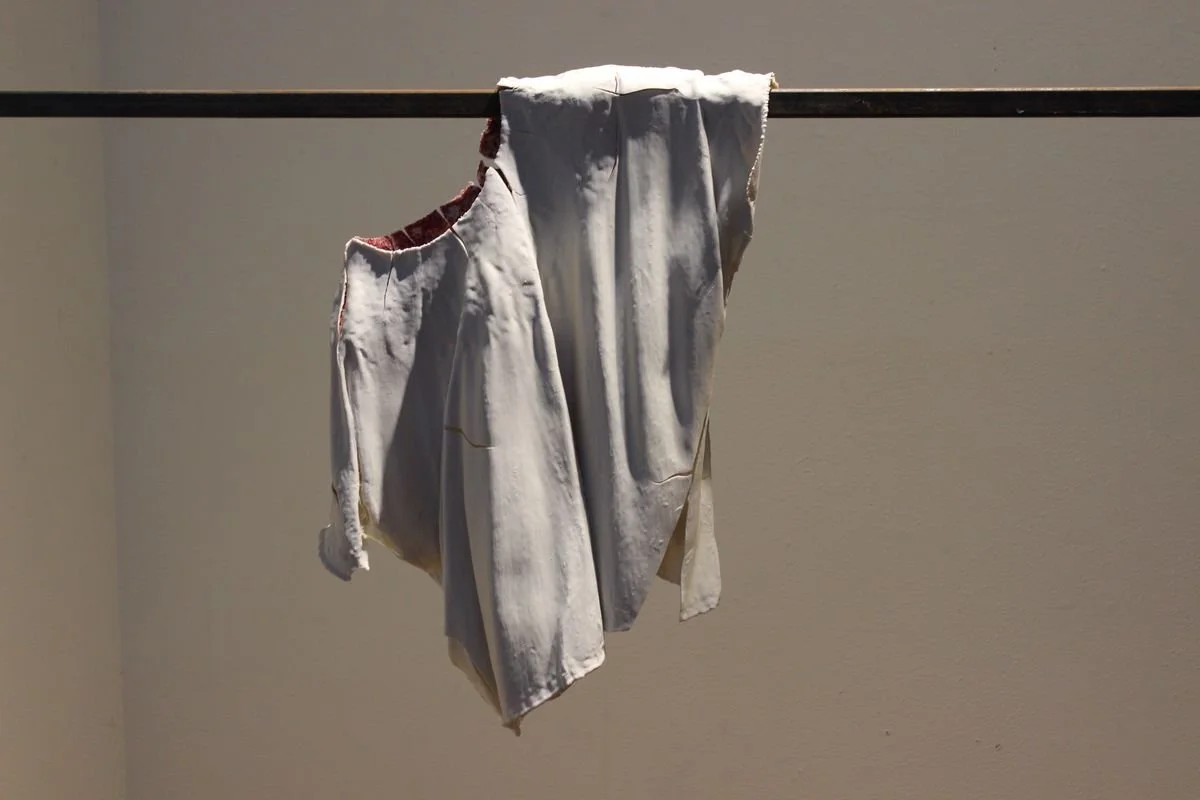Leaf 2
Ghosts
Breaking Light [the Palace of Governors]
Secreted within the oldest building in New Mexico—with cracked brick walls dating to 1610—are two galleries hidden within the rambling Palace Collection. Despite the small, Once within A Time poster, to find “Desert Gleam”, I twice crossed the grassy courtyard looking, but not finding, until a concerned guard pointed the way. As with the other, tantalizingly distributed Site Santa Fe sites aloneness and athwartness suit these starkly white rooms. Think of them as solo performances, in the manner of Anton Webern’s Six Bagatelles , [1910-1913], slowly unrolling in almost imperceptible movements.
Imagine a silent, otherwise empty, room—a sort of Minimalist construction site—housing, slender floor-to-ceiling darkened steel rods. These walkabout verticals create the windless effect of a thinned forest uplifting, at different heights, bright plexiglass boxes. Neither appearing to fall or to cling, these transparent vitrines simply await. Their sealed and isolated relics resemble stiffened porcelain shrouds: a child-sized shirt owned by journalist Alicia Inez Guzman worn at a 2023 Los Alamos meeting dealing with the handling of priceless silvery plutonium; two hanging leather belts woven by Navaho artist, Porter Zwentzell, along with his stiffened moccasin boots from twenty years before. All dipped in “white gold” or porcelain [kaolin, feldspar, quartz]. Together they inhabit intangible worlds where nothing stirs. And yet.
Charisse Pearliner Weston creates both a fleshless history, a remoteness that is nonetheless contemporary [one box sits on the floor containing reddish soil from an ongoing Mexican excavation site]. At first glance, the exhibition’s take on temporality is not so much one of passing, but as past. Gradually, we experience the chronological variability [the boxes on the side holding Old West Remington pistols, a Spanish retablo, a Pueblo mortar and pestle : all borrowed from the Palace Collection]. Not to be forgotten either, is the original, low, crumbling -brick doorway, exposed with its splintered log lintel behind glass. Thus suspended, preserved time is continuously ruptured by a lengthening, hovering present.
Significantly, Weston’s historical interest lies not with the conquistador Vazquez de Coronado—but with the outlier, the Moroccan explorer, Estevan de Dorantes—the first African Muslim-- who not only “saw” the seven, supposedly gold-ladened, cities of Cibola in 1539 [and destroyed that legend] but journeyed across the American interior.
This once-enslaved “Moor” and his three shipwrecked non-Native companions, guide her vision of otherness, migration, and wealth in the Southwest. The treasures of this mythic Eldorado –which these men marched towards for some 3000 miles, reputedly glittered so fiercely that they gilded the surrounding Sangre de Cristo mountains and transformed the crystalline desert into a mirror.
Shine and shadow rule the second white gallery as well. Slightly offset, tall architectural panes of tempered laminate glass rise from unstable base to sharpened rim. Almost imperceptibly askew, they sit uneasily on a white pedestal set before a window flanked by—and concealing—a small , unfurling, black hot-folded float glass tilted into the wall. On the verge of deletion , fragments of the artist’s etched handwriting [ “membranes,” “soft tissue,” “to forge,” crackling”] vanish into its surface. Taken together, this chiaroscuro stretch of gleam is swallowed by the angled, ashen fireplace—the sooty hole in the gallery.
Next to this wound-like gap, but offset, hangs a large inkjet monoprint on stickily epoxied canvas—coated with glistening frit shattered glass, deep purplish ink, tinted severed shards—whose opacity challenges the clarity across the way. This tumultuous collage pictures the sensuous resistance of a soft, shifting inner space, one deliberately separating itself from the rigidity, as well as breaking the hard distinctions, teetering on the other side of the white room. Both galleries conjure imaginary, or lost, lands and offer glimpses of an ebbed past pushing into the chaotic present.
